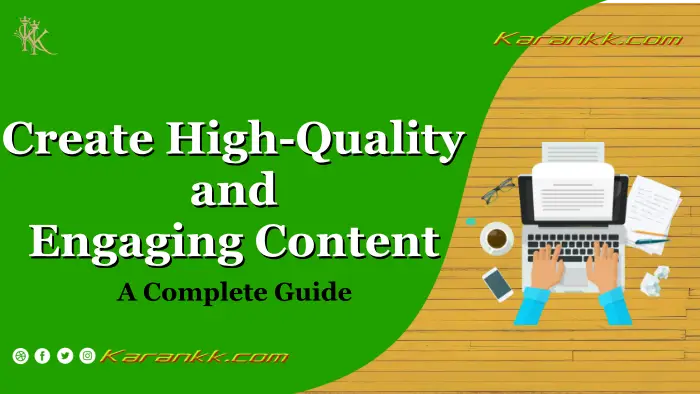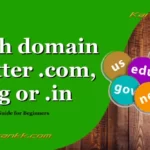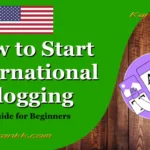In today’s digital age, content is king. Social media and the expansion of the internet have provided individuals and businesses with a huge platform to connect with their target audience.
However, it might be difficult to stand out from the crowd given the volume of information that is created every day.
The secret to grabbing your audience’s attention and increasing website traffic is to provide high-quality and interesting content.
In this post, We’ll discuss the significance of creating engaging, high-quality content and provide you with some helpful tips on how to succeed in it.
- 1 Why High-Quality and Engaging Content Matters
- 2 Understanding Your Audience
- 3 Identifying Your Goals
- 4 Conducting Keyword Research
- 5 Crafting Your Headline
- 6 Structuring Your Content
- 7 Using Visuals to Enhance Your Content
- 8 Incorporating Calls-to-Action
- 9 Optimizing Your Content for SEO
- 10 Promoting Your Content
- 11 Monitor Your Success
- 12 Common Content Mistakes to Avoid
- 13 Conclusion
- 14 FAQs
Why High-Quality and Engaging Content Matters
It’s important to provide high-quality and interesting content for a number of purposes. First, it helps you establish yourself as an authority in your industry.
When you produce valuable and insightful content, your audience will begin to view you as a thought leader, and they will be more likely to trust your recommendations and purchase your products or services.
Second, you may improve the traffic and engagement on your website by creating high-quality and interesting content.
Your audience will be more motivated to share the content with their friends and followers if it speaks to them, which will increase social media engagement and the number of backlinks to your website.
Lastly, creating high-quality and engaging content is essential for SEO. Search engines like Google prioritize content that is informative, engaging, and relevant to the user’s search query.
By creating content that meets these criteria, you can improve your website’s visibility and drive more organic traffic to your site.
Understanding Your Audience
The first step in creating high-quality and engaging content is to understand your audience.
You may make the content more relevant to your audience’s requirements and interests by responding to these questions.
To understand your audience, start by creating buyer personas. A buyer persona is a fictional representation of your ideal customer.
It includes information about their demographics, interests, pain points, and purchasing habits.
Once you have a clear understanding of your buyer persona, you can create content that speaks directly to them.
Identifying Your Goals
Before you start creating content, it’s essential to identify your goals.
Once you have identified your goals, you can create content that aligns with those goals.
Conducting Keyword Research
Keyword research is the process of identifying the words and phrases that people use to search for content online.
By conducting keyword research, you can identify the keywords that are relevant to your industry and audience and create content that targets those keywords.
To conduct keyword research, start by using a keyword research tool like Google Keyword Planner.
Enter a keyword or phrase that is relevant to your industry, and the tool will provide you with a list of related keywords, along with information about their search volume and competition level.
Use this information to identify the keywords that are most relevant to your audience and incorporate them into your content.
Crafting Your Headline
Your headline is the first thing that your audience sees when they come across your content. It’s essential to create a headline that is attention-grabbing and informative.
Structuring Your Content
The structure of your content is critical to its readability and engagement. When creating content, it’s essential to break it up into small, easily digestible sections, with clear headings and subheadings.
As a result, it will be simpler for your readers to scan your material and discover the details they need.
When structuring your content, start with an introduction that captures your audience’s attention and provides an overview of what they can expect to learn from your content.
Follow this with the main body of your content, which should be broken up into several sections, each with its own heading.
Finally, end your content with a conclusion that summarizes the key points and provides a call to action.
This could be a link to a related article, a sign-up form for your newsletter, or a request to follow you on social media.
Using Visuals to Enhance Your Content
Visuals are an excellent way to enhance your content and make it more engaging. This could be in the form of images, infographics, or videos.
Visuals can help to break up your content, making it easier to read, and can also help to illustrate complex concepts.
It’s important to make sure that any graphics you include are high-quality and relate to your text. Poor-quality visuals can detract from your content and make it less engaging.
Incorporating Calls-to-Action
A call-to-action (CTA) is a statement that encourages your audience to take a specific action. This could be signing up for your newsletter, downloading a free guide, or purchasing a product.
CTAs are essential because they help to guide your audience through the sales funnel and can ultimately lead to increased conversions.
When incorporating CTAs into your content, it’s essential to make them clear and compelling. Use action-oriented language, and make it easy for your audience to take the desired action.
Optimizing Your Content for SEO
Optimizing your content for SEO is critical to its success. SEO, or search engine optimization, is the process of optimizing your content to rank higher in search engine results pages (SERPs).
This can lead to increased visibility, traffic, and ultimately, conversions.
When optimizing your content for SEO, start by incorporating your target keywords into your content.
This includes your headings, subheadings, and body copy. Be sure to use your keywords naturally and avoid keyword stuffing, which can lead to penalties from search engines.
Other ways to optimize your content for SEO include optimizing your images, using internal and external links, and ensuring that your website is mobile-friendly.
Promoting Your Content
Promoting your content is essential to its success. While making high-quality and engaging content is important, it’s equally important to ensure that your content gets your target audience.
To promote your content, start by sharing it on your social media channels. You can also reach out to influencers in your business and ask them to share your content with their fans.
Finally, consider using paid advertising to reach a broader audience.
Monitor Your Success
Monitoring your content’s success is essential to improving your content strategy over time.
Use tools like Google Analytics to track your website’s traffic, engagement, and conversions.
Use this information to identify what is working and what isn’t, and adjust your content strategy accordingly.
Common Content Mistakes to Avoid
When creating content, there are several common mistakes that you should avoid. These include:
Conclusion
Creating high-quality and engaging content is essential to your success online. By understanding your audience, identifying your goals, and following the best practices outlined in this article, you can create content that resonates with your audience and drives results.
You should always arrange the content so that it is simple to read and scan, add clear calls to action, utilize images to enhance your message, and properly market it.
By Monitoring your success and avoiding common content mistakes, you can continuously improve your content and achieve your goals.
Start a Blog and Make Money Online ( Free Full Guide )
- How to Start a Blog
- How to Choose a Niche
- How to Choose a Blogging Platform
- How to Choose the Perfect Domain Name
- How to Choose a Domain Name for a Personal Website
- How to Sign Up with Hostinger
- How to install WordPress in Hostinger
- How to Install GeneratePress Premium
- How to Install Essential Plugins
- Best Keyword Research Tool
- Create High-Quality and Engaging Content
- How to Optimize Your Content for SEO
- How to Monetize Your Blog
- How to Promote Your Blog
FAQs
How often should I create new content for my website?
There is no set rule for how often you should create new content for your website. It depends on your industry, audience, and goals. However, creating high-quality content consistently is key to building your brand and driving results.
Can I reuse old content on my website?
It’s possible to repurpose and update old content for your website. However, it’s essential to ensure that the content is still relevant and valuable to your audience.
How do I know what type of content my audience wants to see?
You may learn more about the kinds of content that engage with your audience through market research, examining your website and social media statistics, and conducting surveys.
Should I focus on quantity or quality when creating content?
Quality should always be the priority when creating content. However, it’s important to make enough content to meet the wants of your audience and achieve your goals.
How long should my content be?
The length of your content depends on your industry, audience, and goals. However, it’s essential to ensure that your content is comprehensive and provides value to your audience, regardless of its length.






